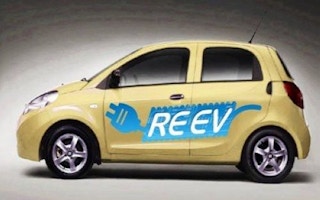The toylike electric cars at the Shanghai Auto Show are a glimpse of the high-tech automotive future China’s leaders are pursuing.
However they are also a sign of possible disputes with China’s trading partners.
Geely’s two-seat McCar, Dongfeng’s Shuaike microvan, the four-seat M1 REEV from Chery and others promise a range of more than 100 kilometres.
Most of these models are still in development but some are appearing on China’s streets.
Beijing sees electric cars as a field where it can take a global lead, helping to transform China into a creator of technology.
But while it pushes its fledgling automakers to create their own products, it also has alarmed global producers that operate in China by pressing them to hand over know-how and limiting access to its market.
Draft investment rules issued last month would allow foreigners to own only a minority stake in Chinese manufacturers of electric car components.
Next month, Beijing is due to release a 10-year industry development plan for “new energy vehicles,” and automakers worry it will impose further curbs on production or imports.
Foreign manufacturers are concerned Beijing might require them to hand over valuable technology and help local partners create “indigenous brands” as the price of being allowed to sell electric cars in China.
“They certainly worry about that,” said John Zeng of JD Power and Associates.
“They are still at the stage of investing heavily in research and development. So right now, they are not ready to transfer technology.”
Beijing already requires that for a foreign manufacturer to produce an electric car in China, its local joint venture must own the technology for one of the three “core components” - the battery, the motor or the power-management system.
Developing powerful but safe batteries has been a key challenge for Chinese automakers.
Batteries in Chinese cars have exploded more than 10 times during development, the business magazine Caijing reported this month.
“This makes drivers not dare to drive these cars,” the magazine said.
Electric cars are the latest industry in which Beijing hopes to use China’s fast-growing market as leverage to develop its own technology and global brands.
It passed the United States in 2009 in number of vehicles sold annually and foreign producers are looking to China to drive sales, putting them under pressure to co-operate.
Beijing requires foreign automakers in China to operate in joint ventures, in hopes their local partners will learn and grow.
But communist leaders have been disappointed with the results: Today, China’s market is dominated by General Motors, Volkswagen and other foreign brands.
Local producers such as Chery and Geely, the new owner of Sweden’s Volvo Cars, are growing fast but are far behind.
Electric cars offer a fresh start in a field with no entrenched leaders.
“They see it as a big opportunity. They want to be dominant in some vehicle market and the old technologies have already been taken,” said Deborah Seligsohn, a researcher in Beijing for the Washington-based World Resources Institute.
Electric cars also are a key part of China’s efforts to curb its voracious appetite for imported oil and gas, which communist leaders see as a strategic weakness.
“The energy security advantages for them are enormous,” said Seligsohn.
“Switching people to electricity that you can produce domestically is very appealing.”
Beijing has long pushed for technology transfer in fields from high-speed rail to clean energy as a condition of contracts or licences.
China’s bullet trains are based on European and Japanese technology but are being marketed in Latin America and the Middle East, prompting complaints it is violating the spirit of such agreements.
China’s auto manufacturing policies have provoked disputes with Washington and other trading partners.
The United States, Europe and Canada launched a World Trade Organisation case in 2006 challenging Beijing’s effort to compel automakers to use Chinese-made components by imposing higher taxes on cars made with more than 40 per cent foreign parts. The WTO ruled against Beijing in 2008 but by then automakers had developed local suppliers.
Automakers see China as an important centre to develop electric technology as well as a huge potential market.
Beijing is trying to generate demand by promising subsidies of 60,000 yuan ($A8,592) per electric vehicle. Cities are being given grants to buy electric buses and taxis.
Ford announced this week it will provide three hybrid and all-electric vehicles to government agencies and later to consumers to study how Chinese drivers use them.
Ford is recruiting Chinese engineers to work on alternative cars, said Nancy Gioia, a Ford executive with the futuristic job title Director of Global Electrification.
Alternative vehicles at the Shanghai auto show reflect the complex relations between Chinese automakers and foreign companies that provide advanced technology and are both partners and potential rivals.
Dongfeng Motor Co’s plug-in Shuaike is produced in a joint venture with Nissan. Dongfeng says the vehicles have been sold to government agencies and future public sales might be possible.
But Nissan plans to import its all-electric Leaf rather than produce them in China, possibly to avoid having to share more advanced technology.
Germany’s Daimler AG, maker of Mercedes Benz cars, is creating a new electric car brand with Chinese automaker BYD and plans to launch a model in 2013. Daimler’s CEO for Northeast Asia, Ulrich Walker, said it went that route because it wants to create a separate, lower-cost brand, not because of government pressure.
At the same time, BYD is developing its own vehicles.
The company is testing its F3DM hybrid in Los Angeles and says it hopes to start US sales of its K9 electric bus in 2012. BYD’s e6 sedan, which promises a 300-kilometre range, has been tested in taxi fleets in the southern Chinese city of Shenzhen for the past year.










